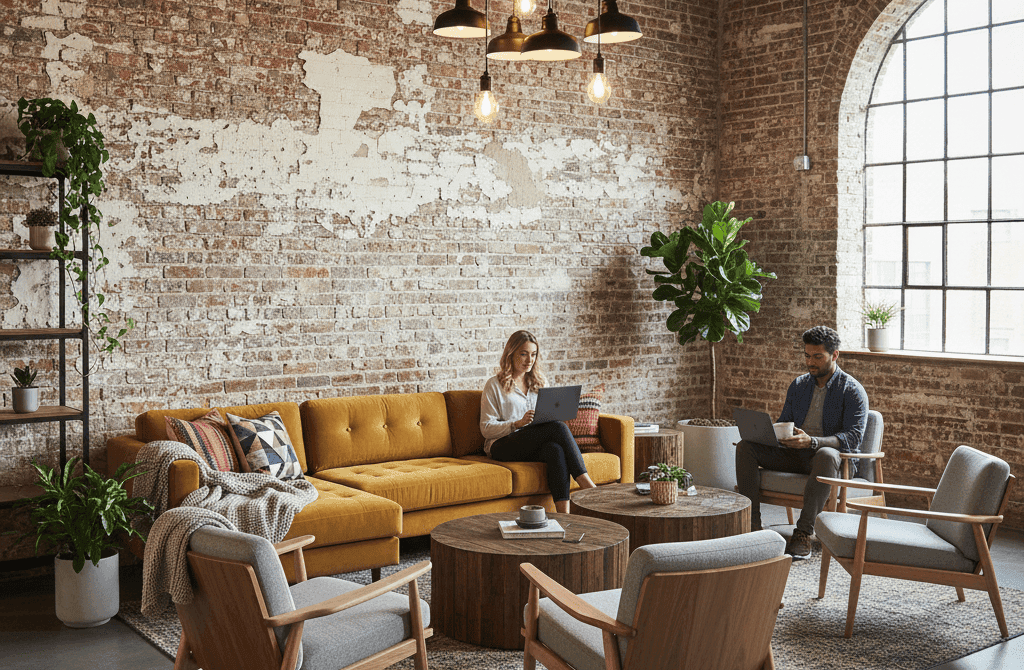7 Bold Ideas Shaping Modern Coworking Design
There’s something about stepping into a coworking space that either fuels you or drains you. It’s not just the Wi-Fi speed or the free coffee — though, sure, those help. It’s the way a space feels the moment you walk in. That first impression isn’t an accident. It’s the product of deliberate choices — some subtle, some in-your-face — that together make the difference between a dull office and a place people actually want to work in.
We’ve hit a turning point. Coworking design isn’t just about desks and chairs anymore. It’s about psychology, emotion, flow. It’s about building environments that encourage connection and focus while leaving space for solitude. And if you’re thinking about creating or updating a shared workspace, the ideas shaping the best ones in 2025 are worth stealing.
1. Embracing Bold Minimalism
Minimalism has matured. It’s no longer the sterile white-on-white cliché. Today’s bold minimalism is confident, warm, even daring. Picture clean lines paired with tactile finishes — raw concrete next to walnut wood, matte steel beside soft linen. The visual quiet calms the mind, but the textural play keeps the senses awake.
In coworking spaces, this approach helps strip away distraction. No clutter screaming for attention. Just intentional design choices that guide the eye and anchor focus. You don’t feel like you’re in an art gallery. You feel grounded, centered, ready to build something.
And yet, there’s enough personality — a sculptural light here, a geometric shelving unit there — to stop the place from feeling soulless. The trick is balance: enough restraint to promote clarity, enough boldness to spark creativity.
2. Designing for Heritage and Modernity
It’s tempting to think that coworking spaces must look futuristic to feel relevant. But some of the most inspiring ones blend the past and present into a seamless whole. It’s a concept rooted in heritage balance — honoring the character of a building while weaving in modern function.
You see it in former factories turned creative hubs, where old brick walls meet polished concrete floors. Or in century-old townhouses that now house tech startups, frescoes intact, meeting pods tucked discreetly beneath them. These spaces hum with history without getting stuck in it.
The contrast tells a story. It reminds people they’re part of something bigger — a continuum of work, ideas, and human effort. And that sense of continuity can be strangely motivating.
3. The Power of Contrast in Space
Speaking of contrasts, few things shape mood and behavior like deliberate opposites. Light against dark. Rough against smooth. Old bones against new skin. It’s the heartbeat of many striking coworking environments.
One office that nails this concept focuses on spatial contrast — not just visually, but emotionally. Think towering historic frescoes paired with modular glass meeting rooms. Think exposed beams beside razor-sharp LED strips. The tension between eras creates energy. And that energy translates into creative momentum.
The lesson? Don’t fear contrast. Lean into it. When done well, it doesn’t create conflict — it creates conversation.
4. Lighting as a Design Language
Lighting is more than a utility. It’s mood, it’s rhythm, it’s communication. In coworking spaces, where people move through different mental states — deep focus, casual chat, pitch-meeting adrenaline — lighting can guide those transitions without a single word.
A well-placed lighting fixture can do more than illuminate a room. It can become a sculptural statement, a subtle boundary, a cue that this corner is for collaboration while that nook invites introspection. Layered lighting, from ambient washes to pinpoint task beams, lets a space shift gears throughout the day.
And beyond function, lighting shapes atmosphere. Soft, warm pools of light feel human and inviting. Harsh, uniform glare? Not so much.
5. Smart Zoning and Fluid Space
One of the toughest design puzzles in coworking is zoning — how to carve out different areas without slicing up the space. Traditional walls feel too rigid, too final. That’s why flexible dividers, movable partitions, and even furniture itself are stepping into that role.
Here’s where the INSERT phrase lands naturally: Here they often use office glass partitions, which create a sense of privacy without losing open space.
Transparency is the trick. You want separation, but not isolation. A sense of flow, not fragmentation. This approach keeps sightlines open and light abundant while still offering nooks for focused work or private calls. It’s a subtle but powerful shift in how space is experienced.
6. Affordable Luxury, Done Right
Coworking spaces don’t need gold-leaf staircases to feel premium. A few smart choices can elevate even a tight budget. One approach is layering premium finishes — think matte black fixtures, rich wood veneers, or polished terrazzo floors. They deliver visual richness without outrageous cost.
Pair that with statement lighting and thoughtful furniture, and suddenly the space feels intentional. Small details — a perfectly aligned shelf, a tactile wall finish — do heavy lifting. People notice. They might not articulate why the place feels so good, but they feel it all the same.
That subconscious impression is worth more than a dozen neon signs proclaiming “We’re cool.”
7. Productivity Through Thoughtful Organization
Finally, the most beautiful coworking space means little if it doesn’t work. Organization — the invisible framework — is what makes a space actually usable. Clever storage, smart circulation, unobtrusive cable management. It’s not sexy, but it’s essential.
A well-designed defined zone for focused work, another for spontaneous collaboration, and a few in-between spaces for everything else — that’s the sweet spot. Too open and chaos creeps in. Too segmented and energy dies.
It’s about choreographing flow. Giving people choices without overwhelming them. Guiding them subtly toward the right space for the right task.
Looking Ahead
Coworking spaces aren’t static. They evolve as the way we work evolves. As remote work blurs into hybrid models, as teams shrink and grow, as new industries emerge, these spaces have to stay flexible — and inspiring.
Design is the language that makes that possible. It’s how we communicate values without words. It’s how we make people want to come in, day after day, and do their best work. Whether it’s through material contrasts, lighting cues, or subtle zoning tricks, the goal is the same: build places that make people feel alive and capable.
And maybe that’s the real heart of coworking design. It’s not about furniture layouts or paint colors — though those matter. It’s about emotion. Belonging. Potential. A well-designed space whispers: You can do something meaningful here.

FAQs
Q: What’s the most important design element in a coworking space?
A: Flexibility. Spaces need to adapt quickly to changing team sizes, work styles, and tasks without expensive renovations.
Q: How can small coworking spaces feel larger?
A: Maximize natural light, use transparent partitions, and keep sightlines open to avoid visual clutter.
Q: Are historic buildings good for coworking conversions?
A: Absolutely. The contrast between heritage features and modern needs can create dynamic, inspiring work environments.
Q: How does lighting affect productivity?
A: Thoughtful lighting design supports different work modes, boosts mood, and reduces eye strain, directly impacting focus and creativity.
